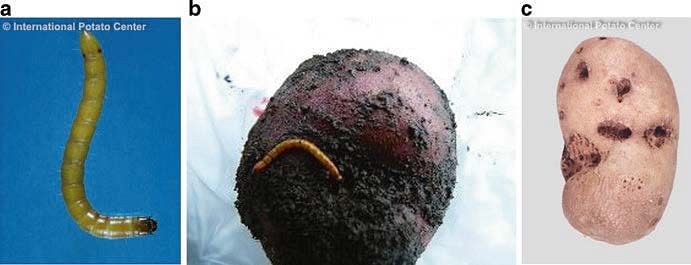Scientific description of the Wireworms (2020)
The authors of this content are Jürgen Kroschel, Norma Mujica, Joshua Okonya, Andrei Alyokhin
Agriotes lineatus (L.), A. vobscurus (L.), A. sputator (L.)., Athous haemorrhoidalis (F.), Conoderus rudis (Brown), C. vespertinus (Fabricius), Ctenicera pruinina (Horn), C. cuprea (Fabricius), Melanotus communis (Gyllenhal) (Coleoptera: Elateridae)
Distribution
Wire worms are the larvae of click beetles (image below). Over 39 species in 21 genera of wireworms have been reported to attack potato. Wireworms are found throughout the world, and species vary greatly among regions.
While in the UK, the three most important pest species in potato are Agriotes lineatus, A. vobscurus, and A. sputator, in the US, these are Limonius canus LeConte, Limonius californicus (Mannerheim), A. lineatus, A. obscurus L. and A. sputator.
Wire worms are the larvae of click beetles (image below). Over 39 species in 21 genera of wireworms have been reported to attack potato. Wireworms are found throughout the world, and species vary greatly among regions.
While in the UK, the three most important pest species in potato are Agriotes lineatus, A. vobscurus, and A. sputator, in the US, these are Limonius canus LeConte, Limonius californicus (Mannerheim), A. lineatus, A. obscurus L. and A. sputator.

Wireworm larvae (a, b) and larval damage on potato tuber (c). (Courtesy: CIP)
Host range
Grasses are the main host but they also attack potato, asparagus, carrot (Daucus carota subsp. sativus (Hoffm.) Schübl. & G. Martens), sugar beet (Beta vulgaris L.) and leek (Allium ampeloprasum L.)
Wireworms are frequent pests in temperate climates, but less so in warm tropical areas. Thin, lustrous larvae with small thoracic legs live underground and may be up to 25 mm long. The larvae can borrow deeply inside tubers, and spend considerable time over there producing irregularly shaped tunnels in tubers (CIP 1996; Larrain et al. 2003; Sanchez and Vergara 2002).
Grasses are the main host but they also attack potato, asparagus, carrot (Daucus carota subsp. sativus (Hoffm.) Schübl. & G. Martens), sugar beet (Beta vulgaris L.) and leek (Allium ampeloprasum L.)
Wireworms are frequent pests in temperate climates, but less so in warm tropical areas. Thin, lustrous larvae with small thoracic legs live underground and may be up to 25 mm long. The larvae can borrow deeply inside tubers, and spend considerable time over there producing irregularly shaped tunnels in tubers (CIP 1996; Larrain et al. 2003; Sanchez and Vergara 2002).
Impacts on production losses
Wireworms may injure potatoes by feeding on the seed piece resulting in weak stands, but most of their damage is caused by tunneling into tubers, which reduces yield quality. Wireworm tunneling also creates an entry point for certain plant pathogens, eventually leading to tuber rot. In some years and regions of the U.S., up to 45% of the total potato tuber harvest has been downgraded or rejected outright because of wireworm injury, resulting in the substantial economic loss (Steele 2011).
Wireworms may injure potatoes by feeding on the seed piece resulting in weak stands, but most of their damage is caused by tunneling into tubers, which reduces yield quality. Wireworm tunneling also creates an entry point for certain plant pathogens, eventually leading to tuber rot. In some years and regions of the U.S., up to 45% of the total potato tuber harvest has been downgraded or rejected outright because of wireworm injury, resulting in the substantial economic loss (Steele 2011).
Methods of prevention and control
- Monitoring.
Avoid growing potatoes in wireworm infested fields. Plan and utilize a range of risk assessment methods such as pheromone and bait trapping, as well as soil sampling to confirm the status of each field. In arable rotations, plough-based cultivation may help to reduce wireworm populations (Larrain et al. 2003). - Cultural control.
Wireworms feed on the roots of various crops, particularly grasses. Consequently, before planting potatoes in pasture areas, the soil borne wireworm larvae population must be reduced by proper plowing and rotation with other crops that require frequent tilling. Keeping potato fields free from weeds has also been reported to reduce wireworm populations.
- Biological control.
Currently, there are no commercial biological control agents available for controlling wireworms, although some strains of the insect-pathogenic fungus Metarhizium anisopliae have shown promising results under experimental conditions (Kabaluk et al. 2005). - Chemical control.
Insecticides applied to the soil may be required in certain circumstances. To be effective, insecticides for the control of wireworms need to be incorporated into the soil at planting and remain active during the cropping season (Parker and Howard 2001).
